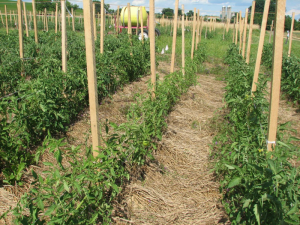Rolling or mowing high-residue cover crops like rye and vetch can provide a weed-suppressing and moisture-holding mulch into which vegetable and grain crops can be direct seeded or transplanted. These systems have been successful for tomatoes, pumpkins, broccoli, and other vegetable crops that are later-planted and are not negatively affected by the soil cooling effect of mulch.
Terminating cover crops in timely manner in spring/summer can be one of the most challenging aspects of these systems. Many growers who use herbicides terminate their cover crops chemically before they can be killed mechanically. Attempting to kill a cover crop mechanically before flowering will result in regrowth. This limits the timing for organic growers, many of whom find they cannot wait until mechanical termination is possible for their first round of some cash crops. Nonetheless, these high-residue systems show a lot of potential for weed suppression, moisture conservation, and erosion reduction.
In general, it is believed that rolling/crimping leads to better weed suppression and more uniform residue placement than mowing, resulting in less equipment trouble when planting the following crop. However, some reports have indicated that flail mowing of cover crops is equally effective.
Even though cover crop mulch provides some weed control, it may not be sufficient for the whole growing season. It has been estimated that to achieve 75% inhibition of weed emergence, 10 cm (4 inches) of biomass is necessary (read more on mulch and weed suppression). Dr. Gerald Brust at University of Maryland looked at using a weed barrier (cloth) for just 1-2 weeks early in the season, and found it increased weed control substantially in organic tomatoes. We recently tried using supplemental tarps to kill rye, vetch and weeds and had some encouraging results in our first trial with black tarps. In Germany, researchers are experimenting with supplemental cut-and-carried mulch for increasing weed suppression.
Further Reading and Watching
There is a lot of information on rolling/crimping cover crops, but relatively little information on using these cover crop-based systems for vegetable production. The resources listed here cover different parts of the country and we suggest contacting some of the experts in your region for more information.
Weed ’em and Reap Part II: High residue systems (Videos) featuring Mark Schonbeck, Ron Morse, and others. These videos are incredibly helpful for people considering high-residue systems and have great visuals.
Organic Reduced Tillage in the Pacific Northwest eOrganic page of the Washington State University project. Includes regionally important information and cover crop variety trials for the Pacific Northwest.
Reduced Tillage and Cover Cropping Systems for Organic Vegetable Production by Mark Schonbeck and Ron Morse. Project supported by Southern SARE.
Facilitating Improved Soil Quality on Organic Farms through Research and Training on No-Till Organic Vegetable Production in the Midwest Update on 2010 project at Iowa State University with no-till broccoli and squash.
What is “Organic No-till” and is it Practical? by Mark Schonbeck (from eOrganic)
High-Residue No-till Systems for Production of Organic Broccoli, by Ron Morse.
Keys to Successful Production of Transplanted Crops in High-Residue No-till Farming Systems, by Ron Morse.
 Rodale Institute has published a report, Beyond Black Plastic, on using cover crop mulches for no-till vegetable production. These systems have come a long way in the last 20 years.
Rodale Institute has published a report, Beyond Black Plastic, on using cover crop mulches for no-till vegetable production. These systems have come a long way in the last 20 years.
Cover Crops and No-Till Management for Organic Systems, from the Rodale Institute. (includes nice pictures and discussion of equipment needed for high-residue transplanting and cultivation as well as an extensive reference list).




